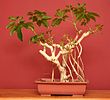Heptapleurum arboricola (syn. Schefflera arboricola, Chinese: 鹅掌藤; pinyin: ézhǎng téng; lit. 'goose-sole vine') is a flowering plant in the family Araliaceae, native to Hainan Province, China and Taiwan.[1][2][3] Its common name is dwarf umbrella tree, as it resembles a smaller version of the umbrella tree, Heptapleurum actinophyllum.[4]
| Heptapleurum arboricola | |
|---|---|
 | |
| Scientific classification | |
| Kingdom: | Plantae |
| Clade: | Tracheophytes |
| Clade: | Angiosperms |
| Clade: | Eudicots |
| Clade: | Asterids |
| Order: | Apiales |
| Family: | Araliaceae |
| Genus: | Heptapleurum |
| Species: | H. arboricola |
| Binomial name | |
| Heptapleurum arboricola | |
| Synonyms[1] | |
Schefflera arboricolum | |
Description

It is an evergreen shrub growing to 8–9 m tall, free-standing, or clinging to the trunks of other trees as an epiphyte. The leaves are palmately compound, with 7–9 leaflets, the leaflets 9–20 cm long and 4–10 cm broad (though often smaller in cultivation) with a wedge-shaped base, entire margin, and an obtuse or acute apex, sometimes emarginate.[2][3] The leaves are leathery in texture, shiny green, glabrous on the upper surface and somewhat lighter and matte on the underside. Young plants have smaller leaves and fewer leaflets. Each leaflet has a central rib that divides it into two halves, with between four and six ribs clearly visible up to the third order. The stipules merge with the petiole, the length of which is 12-15 cm.[5]
Flowers
Appearing from midsummer to early autumn, the flowers are produced in a 20 cm panicle of small umbels, each umbel 7–10 mm in diameter with 5–10 flowers.[2] The flowers are hermaphroditic, having a colour ranging from yellow to green and a double perianth radial symmetry. They are composed of an entire annular calyx, five almost fully developed sepals, a corolla with five petals 2.5 mm long, with five stamens and five or six carpels that enclose the ovary. The style is not recognizable and the stigma is established.[3]
Fruits
The fruits have an almost spherical oval drupe, with a diameter of about 5 mm. The endocarp contains five seeds. The fruits ripen from late summer to early winter. They begin as orange glandular points. At maturity, they become red-violet. The fruits are inedible to humans, but may be consumed (and spread elsewhere) by various birds, parrots or other animals.[citation needed]
Distribution
This species is indigenous to China, but has widely naturalized elsewhere. It is now found in the northern, tropical regions of Australia; in areas of Queensland, it has been noted to significantly compete with native species.[6] It has also been introduced to the Ryukyu Islands, Hawaii, Florida, Bermuda, and Jamaica.[1]
Cultivation and uses
Heptapleurum arboricola is commonly grown as a houseplant, popular for its tolerance of neglect and poor growing conditions. It is also grown as a landscape (garden) plant in milder climates where frosts are not severe. Numerous cultivars have been selected for variations in leaf colour and pattern, often variegated with creamy-white to yellow edges or centres, and dwarf forms. The cultivar 'Gold Capella' has gained the Royal Horticultural Society's Award of Garden Merit.[7][8]
Care
The plant prefers bright indirect light, but can adapt to a wide variety of light levels. As a tropical plant, it prefers moisture and humidity, but soil should be well-drained and allowed to dry out between waterings. Allowing the plant to sit in water can cause root rot. The plant can be propagated through cuttings, which will develop roots when placed in soil or water[9]
Aerial roots
Under the right conditions, this plant will produce aerial roots that, when they reach the ground, will convert to fully functional roots. They give the plant an unusual and interesting appearance. Three conditions must be maintained for the plant to produce them: a high growth rate, insufficient trunk roots (the plant is root bound or these roots are pruned) and constant, very high humidity.[citation needed]
Toxicity
All parts of the plant contain calcium oxalate crystals, saponins and terpenoids, toxic compounds which are irritants for cats and dogs. They can cause swelling (in some cases leading to breathing difficulties), burning of the mouth, difficulty swallowing, vomiting, diarrhoea, and itching.[10][11] For humans, the plant is low-severity poison and a skin irritant which can cause contact dermatitits.[12][13]
Photo gallery
- A bonsai from New England.
- A variegated cultivar
- The 'Gold Capella' variety
- An old indoor bonsai presented as a penjing
- Soon after branch pruning, to demonstrate aerial roots
- A garden plant with fruits in Maui
- Seedlings
References
External links
- Fukubonsai, information about Heptapleurum arboricola as indoor bonsai.






